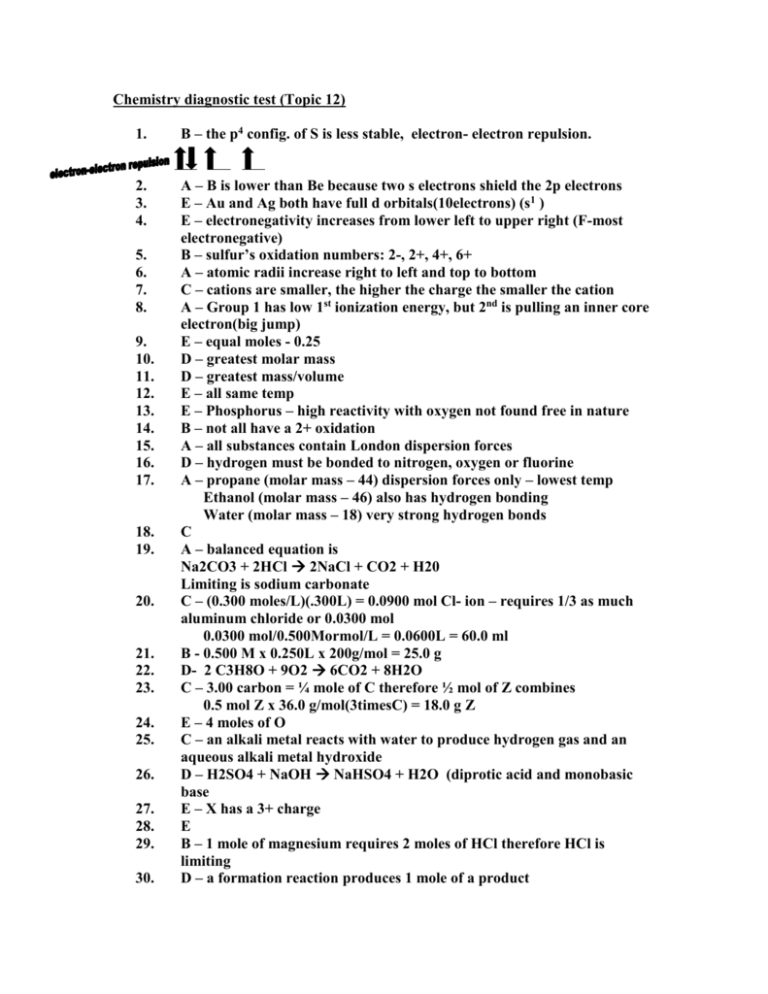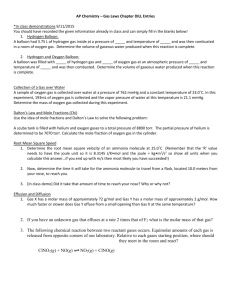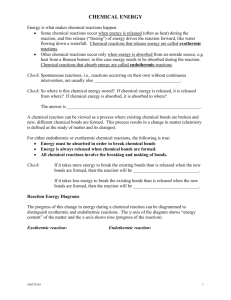Chemistry Diagnostic Test (Topic 12)
advertisement

Chemistry diagnostic test (Topic 12)
1.
B – the p4 config. of S is less stable, electron- electron repulsion.
2.
3.
4.
A – B is lower than Be because two s electrons shield the 2p electrons
E – Au and Ag both have full d orbitals(10electrons) (s1 )
E – electronegativity increases from lower left to upper right (F-most
electronegative)
B – sulfur’s oxidation numbers: 2-, 2+, 4+, 6+
A – atomic radii increase right to left and top to bottom
C – cations are smaller, the higher the charge the smaller the cation
A – Group 1 has low 1st ionization energy, but 2nd is pulling an inner core
electron(big jump)
E – equal moles - 0.25
D – greatest molar mass
D – greatest mass/volume
E – all same temp
E – Phosphorus – high reactivity with oxygen not found free in nature
B – not all have a 2+ oxidation
A – all substances contain London dispersion forces
D – hydrogen must be bonded to nitrogen, oxygen or fluorine
A – propane (molar mass – 44) dispersion forces only – lowest temp
Ethanol (molar mass – 46) also has hydrogen bonding
Water (molar mass – 18) very strong hydrogen bonds
C
A – balanced equation is
Na2CO3 + 2HCl 2NaCl + CO2 + H20
Limiting is sodium carbonate
C – (0.300 moles/L)(.300L) = 0.0900 mol Cl- ion – requires 1/3 as much
aluminum chloride or 0.0300 mol
0.0300 mol/0.500Mormol/L = 0.0600L = 60.0 ml
B - 0.500 M x 0.250L x 200g/mol = 25.0 g
D- 2 C3H8O + 9O2 6CO2 + 8H2O
C – 3.00 carbon = ¼ mole of C therefore ½ mol of Z combines
0.5 mol Z x 36.0 g/mol(3timesC) = 18.0 g Z
E – 4 moles of O
C – an alkali metal reacts with water to produce hydrogen gas and an
aqueous alkali metal hydroxide
D – H2SO4 + NaOH NaHSO4 + H2O (diprotic acid and monobasic
base
E – X has a 3+ charge
E
B – 1 mole of magnesium requires 2 moles of HCl therefore HCl is
limiting
D – a formation reaction produces 1 mole of a product
5.
6.
7.
8.
9.
10.
11.
12.
13.
14.
15.
16.
17.
18.
19.
20.
21.
22.
23.
24.
25.
26.
27.
28.
29.
30.
31.
32.
33.
34.
35.
36.
37.
38.
39.
40.
41.
42.
43.
44.
45.
46.
47.
48.
49.
50.
D – A change of phase from gas to liquid to solid is always exothermic.
Phase changes from solid to liquid to gas are always endothermic
D – Tin is the only metal in that family
A – sodium is bright yellow
B – chromium because half-full d orbitals is more stable thatn filled 4s
C – {Ne}3s2 3p4
s
p
C–4p
A – Methane has the smallest molar mass
A – multiple bonds are stronger. CO – triple bond; O2 & NO double;
others single bonds
A – triple bonds are shortest N2 – triple bond
D – single bonds longer and larger atoms – longer bonds
C – 4 bonding pairs 1 nonbonding
C – nitrate, sulfur trioxide and carbonate are all iso electronic (24 valence
electrons) Lewis structure the same – 2 single bonds to oxygen and 1
double bond to oxygen. Sulfite has 26 valence electrons – 3 single bonds
and 1 nonbonding pair on S.
C
D – ammonia is very polar and can hydrogen bond with water. All others
are non-polar and cannot hydrogen bond
C – (see #42)
C – reduction gains electrons. N from 0 to -3
E – sulfur has an oxidation number of 6+. In sulfide S oxidation number
is 2-, a difference of 8 electrons
D – NaOH + Hcl NaCl +H2o
B – M = (2.00 M)(125.0 mL/500.0 mL) = 0.500M
A – Nitric acid is a strong acid therefore it is a strong electrolyte. It
ionizes completely in aqueous solution








![08 Energetics [4,S]](http://s2.studylib.net/store/data/010232966_1-9ca291145c6e4734bfbb79198d65cc40-300x300.png)


